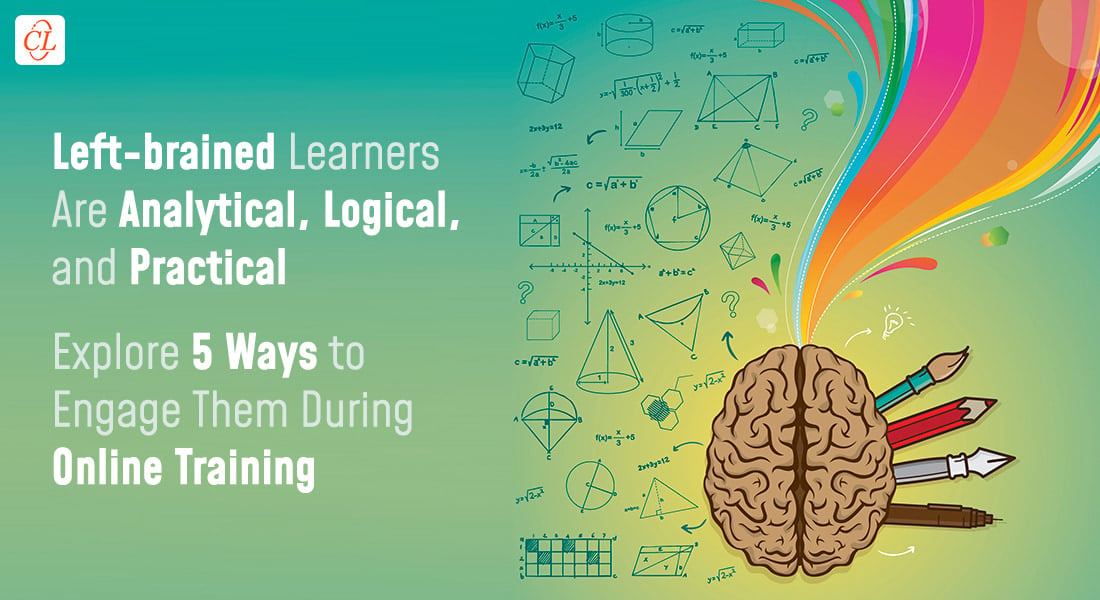5 Ways to Attract ‘Left-Brained’ Online Learners

Are you a logical thinker or a creative thinker? Do you like numbers or colors? Well, it depends on which half of your brain is dominant! Whole-brain learning is a method of learning that involves engaging both sides of the brain. Have you ever examined your learning style or asked yourself what yours might be? Everyone has abilities that are right-brain and left-brain dominant, with one side outweighing the other. In this blog, we look at the characteristics of left-brain learners and a few strategies to engage them online.
Are You Wondering How to Keep Your Left-Brained Learners Motivated Throughout Your eLearning Courses?
Here are 5 tips that might help:
- Detailed Instructions
- Infographics With More Data
- Microlearning Modules
- Simulations and Branching Scenarios
- Asynchronous eLearning Activities
Characteristics of Left-Brain Learners
- Logical
- Realistic
- Analytical
- Practical
- Accurate
All About Left Brain Online Learners and How to Engage Them
We believe the left hemisphere of the brain handles analytical thinking and processing, as well as linguistics, mathematics, and practical reasoning. Online learners who are left-brain dominant have a mind like a steel trap and can memorize massive amounts of information. With that in mind, here are 5 ways for you to connect with your left-brain learners online and provide them with the personalized materials they need.
A Handy Guide to Generate Motivation and Excitement in the Virtual Classroom
5 Ways to Engage Left-Brain Learners
1. Detailed Instructions
Every part of the eLearning course should include thorough instructions. From gaining access to the LMS (learning management system) to completing a branching scenario, you need to supply step-by-step directions for your learners to follow. Left-brain learners excel in reading and following instructions.
This also gives them the framework they require. As a result, through structured eLearning courses left-brain learners are more likely to actively engage in the learning process. To provide them with further support, add online training courses, walkthroughs, and FAQs.
2. Infographics With More Data
While you can draw right-brain learners to languages, you can captivate left-brain learners with mathematics. Left-brain learners seek after data, graphs, and statistics to help them better understand and solve problems. Think about using infographics that show trends, patterns, and other themes with even more statistics.
For instance, consider an infographic on compliance that emphasizes the need for safety standards. Keep in mind, however, that online learners are not immune to cognitive overload. To improve knowledge retention, keep the number of statistics in each infographic to the bare minimum.
3. Microlearning Modules
Goal setting is a favorite pastime of left-brain learners. This is mostly because of their organizational skills and attention to detail. You need to divide work online into small chunks. This is where microlearning comes in.
Microlearning is a learning approach where trainers deliver modules in quick bites. Each module focuses on one learning goal and lasts anywhere from a few seconds to 15 minutes or longer. To reinforce and refresh core microlearning principles, you must use an online training library. You can include eLearning activities, such as:
- Bite-Sized Branching Scenarios
- Real-World Case Studies and Examples
- Video Demos with Online Companion Guides
4. Simulations and Branching Scenarios
Critical reasoning is the left-brain learner’s greatest quality. As a result, through simulations and branching scenarios, they should be able to test their problem-solving skills. You can create a barrier or a challenge for them to overcome. Then let them explore outcomes based on their prior knowledge. Keep in mind that left-brain learners have a keen sense of detail. As a result, design real-world activities that are authentic, practical, and immersive.
5. Asynchronous eLearning Activities
Left-brain learners prefer to fly solo. As a result, self-paced, asynchronous eLearning exercises are an excellent way of engaging these learners. You can allow them to access the learning material at their leisure, and you can keep synchronous eLearning activities like webinars and live Q&As to a minimum. Left-brain learners need a form of social learning to stay engaged, so you must interact with them.
It’s a Wrap
Even if some of your learners are left-brain dominant, keep in mind, both sides of the brain are equally engaged throughout the learning process. There are many ways to keep your learners motivated during an eLearning course. One of them is by implementing VILT (Virtual-Instructor-Led Training). Do you want to learn about learning strategies that are fun, exciting, and engaging? Download this webinar to learn all about the art and science of virtual classrooms!





